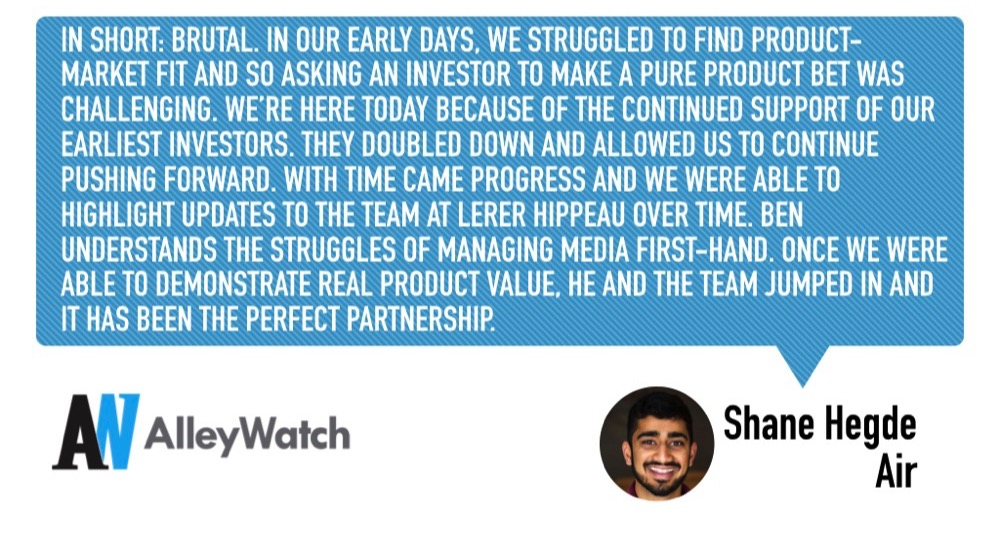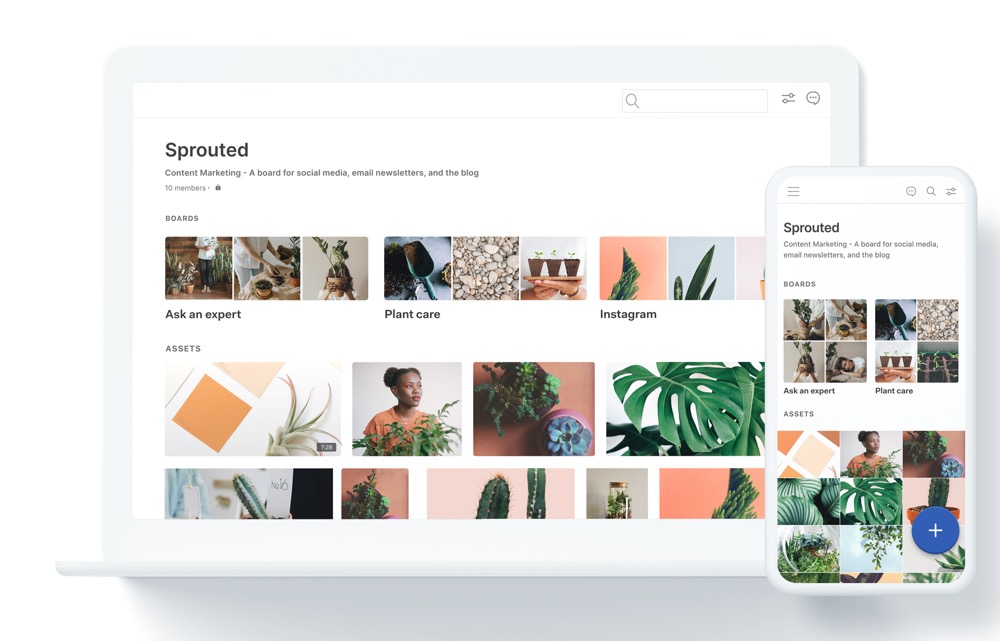Creative teams communicate with images that are usually disparate across many platforms and cloud storage solutions. Managing the workflow is a significant pain point of brand managers, content teams, publishers, and social media teams. Air is the visual collaboration and ideation workplace tool that supports the creative process with an all-encompassing centralized solution. Calling itself the “whiteboard for the creative process”, Air makes it easy for companies to locate image assets/videos, issue feedback, and manage all types of visual media. Air’s media infrastructure platform is currently being used at companies like The Infatuation, Glossier, and Thrillist.
AlleyWatch sat down with CEO and Cofounder Shane Hegde to learn more about Air’s recent funding round and its long-term mission to build the workspace collaboration tool for the entire creative process.
Who were your investors and how much did you raise?
Air has raised $4.5M in a Seed round led by with participation from , Advancit Capital, WndrCo, and a group of strategic advisors including the former ChenLi Wang, Todd Jackson, and Kyle Parrish.
Tell us about the product or service that Air offers.
Air is a workplace collaboration tool for images and videos. We refer to Air as a “whiteboard for the creative process” because it immediately increases productivity for end users like brand marketing managers, content coordinators, and social media managers.
 What inspired the start of Air?
What inspired the start of Air?
When Tyler and I left our jobs to start Air, we did so with a simple thesis – we believed media-specific infrastructure could unlock creativity. Cloud storage wasn’t built for media collaboration. Dropbox and Google Drive don’t support visual workflows.
How is Air different?
Using Air, teams optimize their creative process: importing thousands of images and videos from Dropbox or Google Drive on sign up, giving back on average four hours of their workday that they would have previously spent digging and searching. Manual tasks are replaced with automated structure, and seamless workflow tools enable sharing, commenting, and instant collaboration.
Workspaces are highly visual. Assets are displayed on “boards” rather than folders. This along with powerful search technology gives users a better experience with their content than traditional cloud storage. Your images and videos are always on display and easy to find.
What market does Air target and how big is it?
Air was built for the 700M “communicators” around the globe that work in fields like marketing, sales, and partnerships. For these individuals, visual collaboration is critical, but their creative assets are locked in the hidden corners and messy folders of cloud storage. Our primary customers are brand marketing managers, content coordinators, or social media managers who work in consumer products, goods and services, sports, media, retail, and hospitality.
Who do you consider to be your primary competitors?
We think about this market opportunity through four industry segments: cloud collaboration, creative tools, digital asset management (DAM), and cloud storage.
Cloud collaboration tools ignore visual-centric work, creative tools were not built to house all of your visual assets, existing DAM products are not self-service, and cloud storage applications do not include workflow systems. We target customers who are on cloud storage, providing them with an all-in-one collaboration, creative, and workflow tool.
You are seconds away from signing up for the hottest list in New York Tech! Join the millions and keep up with the stories shaping entrepreneurship. Sign up today
What’s your business and pricing model?
Over 90% of our customers migrate to Air from cloud storage (Dropbox, GDrive, and Box). We are the first piece of dedicated media infrastructure most businesses will purchase, and workspace usually starts with 1-3 seats.
Paid plans start at $10 per user/ month. This includes 100 GB of storage per user. Additional storage is $20 per TB / month.
Enterprise customers who want to migrate from an existing DAM, SAN system, or hard drives connect with us directly and we establish a monthly partnership agreement.
What was the funding process like?
In short: brutal. In our early days, we struggled to find product-market fit and so asking an investor to make a pure product bet was challenging. We’re here today because of the continued support of our earliest investors. They doubled down and allowed us to continue pushing forward. With time came progress and we were able to highlight updates to the team at Lerer Hippeau over time. Ben understands the struggles of managing media first-hand. Once we were able to demonstrate real product value, he and the team jumped in and it has been the perfect partnership.
What are the biggest challenges that you faced while raising capital?
I love the investment community in New York. They expect a succinct business model that is revenue forward. While strong fundamentals are extremely important, my biggest challenge was convincing New York investors that a revenue emphasis too early would pull us away from the larger market opportunity. Self-service SaaS takes time. There’s no way around it. It is an obsession with every touchpoint of the customer journey. Honestly, I feel blessed to have investors like Lerer Hippeau, Red Sea, and Advancit who are willing to make a long-term product bet. I think that is rare outside of Silicon Valley.
What factors about your business led your investors to write the check?
Tyler and I have built, lead, and sold companies in this space. We understand this point and the dynamics in the market. We also absolutely love working in product and I think it came through that we would not stop until Air began to fulfill our wildest dreams. Once we brought Glamsquad, the Infatuation, Room to Read, Twice Toothpaste, and the first crop of partners in our pilot program this passion was supported by data and customer interviews. We hadn’t proven everything, but we had made progress and we knew exactly where we wanted to go next.
Once we brought Glamsquad, the Infatuation, Room to Read, Twice Toothpaste, and the first crop of partners in our pilot program this passion was supported by data and customer interviews. We hadn’t proven everything, but we had made progress and we knew exactly where we wanted to go next.
What are the milestones you plan to achieve in the next six months?
We would like to push onboarding and expansion to be entirely self-service. We launched with a waitlist to continue optimizing our customer journey, but we plan to launch a free tier before the end of the year.
What advice can you offer companies in New York that do not have a fresh
injection of capital in the bank?
For those that are just starting or those that are pushing to turn their dreams into a reality, my simple advice is to keep going! It’s tough. Miserable. I would not recommend this job to anyone. I actually got grey hair! And my personal life is in a constant state of disarray. BUT, if you think it’s worth all of that, keep going!
For those that are just starting or those that are pushing to turn their dreams into a reality, my simple advice is to keep going! It’s tough. Miserable. I would not recommend this job to anyone. I actually got grey hair! And my personal life is in a constant state of disarray. BUT, if you think it’s worth all of that, keep going!
Where do you see the company going now over the near term?
Our goal is to build a workspace collaboration tool for the entire creative process. While this vision is vast, Airtable and Notion have provided us with excellent models for how to attack this market opportunity. Today we start by helping you organize, collaborate, and share your content, but over the next few years you will see us move deeper and deeper into the creative process. Want to create a deck? All of your assets are already on Air… Need to edit a video? Might as well sue the trim tool on Air. Have a PDF that you need to send to a partner? Use a password on your Air share link. The possibilities are endless if we become the central location where businesses manage their visual assets.
What’s your favorite restaurant in the city?
Llama Inn’s roof in the summer is a magical place. The beef! That fish! And don’t even try to sleep on the quinoa. Seriously. The quinoa. It’s warm, homey, and you’ll get a table without having to show them how many followers you have on Instagram. Most important: It’s in Brooklyn!
You are seconds away from signing up for the hottest list in New York Tech! Join the millions and keep up with the stories shaping entrepreneurship. Sign up today




